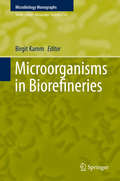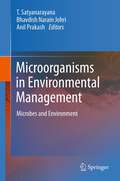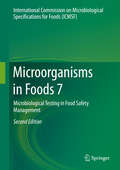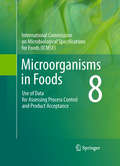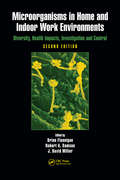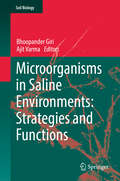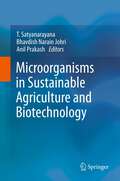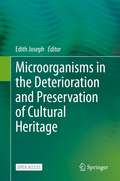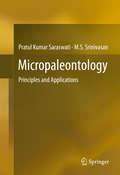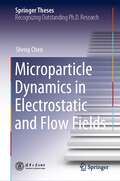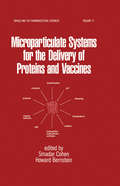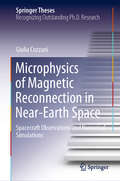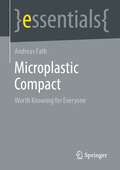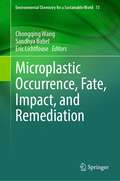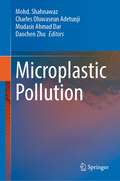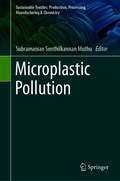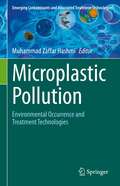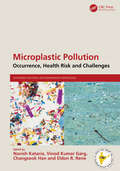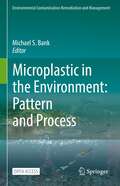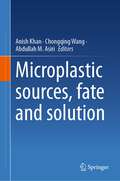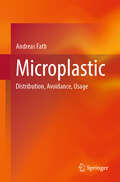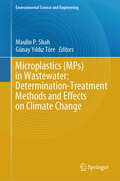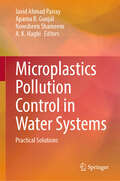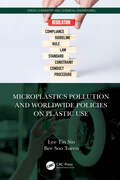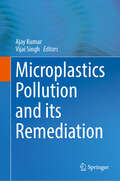- Table View
- List View
Microorganisms in Biorefineries
by Birgit KammThe book describes how plant biomass can be used as renewable feedstock for producing and further processing various products. Particular attention is given to microbial processes both for the digestion of biomass and the synthesis of platform chemicals, biofuels and secondary products. Topics covered include: new metabolic pathways of microbes living on green plants and in silage; using lignocellulosic hydrolysates for the production of polyhydroxyalkanoates; fungi such as Penicillium as host for the production of heterologous proteins and enzymes; bioconversion of sugar hydrolysates into lipids; production of succinic acid, lactones, lactic acid and organic lactates using different bacteria species; cellulose hydrolyzing bacteria in the production of biogas from plant biomass; and isoprenoid compounds in engineered microbes.
Microorganisms in Environmental Management
by Bhavdish Narain Johri Anil Prakash T. SatyanarayanaMicrobes and their biosynthetic capabilities have been invaluable in finding solutions for several intractable problems mankind has encountered in maintaining the quality of the environment. They have, for example, been used to positive effect in human and animal health, genetic engineering, environmental protection, and municipal and industrial waste treatment. Microorganisms have enabled feasible and cost-effective responses which would have been impossible via straightforward chemical or physical engineering methods. Microbial technologies have of late been applied to a range of environmental problems, with considerable success. This survey of recent scientific progress in usefully applying microbes to both environmental management and biotechnology is informed by acknowledgement of the polluting effects on the world around us of soil erosion, the unwanted migration of sediments, chemical fertilizers and pesticides, and the improper treatment of human and animal wastes. These harmful phenomena have resulted in serious environmental and social problems around the world, problems which require us to look for solutions elsewhere than in established physical and chemical technologies. Often the answer lies in hybrid applications in which microbial methods are combined with physical and chemical ones. When we remember that these highly effective microorganisms, cultured for a variety of applications, are but a tiny fraction of those to be found in the world around us, we realize the vastness of the untapped and beneficial potential of microorganisms. At present, comprehending the diversity of hitherto uncultured microbes involves the application of metagenomics, with several novel microbial species having been discovered using culture-independent approaches. Edited by recognized leaders in the field, this penetrating assessment of our progress to date in deploying microorganisms to the advantage of environmental management and biotechnology will be widely welcomed.
Microorganisms in Foods 7: Microbiological Testing In Food Safety Management (Microorganisms In Foods Ser. #Vol. 7)
by International Commission on Microbiological Specifications for FoodsThe second edition of Microorganisms in Foods 7: Microbiological Testing in Food Safety Management updates and expands on information on the role of microbiological testing in modern food safety management systems. After helping the reader understand the often confusing statistical concepts underlying microbiological sampling, the second edition explores how risk assessment and risk management can be used to establish goals such as a “tolerable levels of risk,” Appropriate Levels of Protection, Food Safety Objectives or Performance Objectives for use in controlling foodborne illness. Guidelines for establishing effective management systems for control of specific hazards in foods are also addressed, including new examples for pathogens and indicator organisms in powdered infant formula, Listeria monocytogenes in deli-meats, enterohemorrhagic Escherichia coli in leafy green vegetables, viruses in oysters and Campylobacter in poultry. In addition, a new chapter on application of sampling concept to microbiological methods, expanded chapters covering statistical process control, investigational sampling, environmental sampling, and alternative sampling schemes. The respective roles of industry and government are also explored, recognizing that it is through their collective actions that effective food safety systems are developed and verified. Understanding these systems and concepts can help countries determine whether imported foods were produced with an equivalent level of protection. Microorganisms in Foods 7 is intended for anyone using microbiological testing or setting microbiological criteria, whether for governmental food inspection and control, or industrial applications. It is also intended for those identifying the most effective use of microbiological testing in the food supply chain. For students in food science and technology, this book provides a wealth of information on food safety management principles used by government and industry, with many references for further study. The information was prepared by the International Commission on Microbiological Specifications for Foods (ICMSF). The ICMSF was formed in response to the need for internationally acceptable and authoritative decisions on microbiological limits for foods in international commerce. The current membership consists of fifteen food microbiologists from twelve countries, drawn from government, universities, and food processing and related industries.
Microorganisms in Foods 8
by International Commission on Microbiological Specifications for FoodsMicroorganisms in Foods 8: Use of Data for Assessing Process Control and Product Acceptance is written by the International Commission on Microbiological Specifications for Foods with assistance from a limited number of consultants. The purpose of this book is to provide guidance on appropriate testing of food processing environments, processing lines, and finished product to enhance the safety and microbiological quality of the food supply. Microorganisms in Foods 8 consists of two parts. Part I, Principles of Using Data in Microbial Control, builds on the principles of Microorganisms in Foods 7: Microbiological Testing in Food Safety Management (2002), which illustrates how HACCP and Good Hygienic Practices (GHP) provide greater assurance of safety than microbiological testing, but also identifies circumstances where microbiological testing may play a useful role. Part II, Specific Applications to Commodities, provides practical examples of criteria and other tests and is an updated and expanded version of Part II of Microorganisms in Foods 2: Sampling for Microbiological Analysis: Principles and Specific Applications (2nd ed. 1986). Part II also builds on the 2nd edition of Microorganisms in Foods 6: Microbial Ecology of Food Commodities (2005) by identifying appropriate tests to evaluation the effectiveness of controls.
Microorganisms in Home and Indoor Work Environments: Diversity, Health Impacts, Investigation and Control, Second Edition
by J. David Miller Robert A. Samson Brian FlanniganIn 2007, scientists estimated the direct cost of diseases associated with mould and dampness on the US population to be in the range of 4 billion dollars, and the indirect costs of lost work and school days are gauged even higher. The US Centers for Disease Control recently concluded that elimination of moisture and mouldy materials in the home def
Microorganisms in Saline Environments: Strategies and Functions (Soil Biology #56)
by Ajit Varma Bhoopander GiriThis book gathers the latest findings on the microbial ecology of saline habitats, plant-microbe interactions under saline conditions, and saline soil reclamation for agricultural use. The content is divided into four main parts: Part I outlines the definition of salinity, its genesis and impacts, and microbial diversity in saline habitats. Part II deals with impact of salinity on microbial and plant life/health. Part III highlights plant – microbe interactions in saline environments, and Part IV describes strategies for mitigation and reclamation of saline soils. The salinization of arable land is steadily increasing in many parts of the world. An excessive concentration of soluble salts (salinity) in soils or irrigation water adversely affects plant growth and survival. This problem is exacerbated in arid and semiarid areas due to their low precipitation and high evaporation rates. In turn, poor management practices and policies for using river water for the irrigation of agriculture crops often lead to the secondary salinization of soils.Considering the growing demands of a constantly expanding population, understanding the microbial ecology and interactions under saline conditions and their implications for sustainable agriculture is of utmost importance. Providing both an essential review of the status quo and a future outlook, this book represents a valuable asset for researchers, environmentalists and students working in microbiology and agriculture..
Microorganisms in Sustainable Agriculture and Biotechnology
by Bhavdish Narain Johri Anil Prakash T. SatyanarayanaThis review of recent developments in our understanding of the role of microbes in sustainable agriculture and biotechnology covers a research area with enormous untapped potential. Chemical fertilizers, pesticides, herbicides and other agricultural inputs derived from fossil fuels have increased agricultural production, yet growing awareness and concern over their adverse effects on soil productivity and environmental quality cannot be ignored. The high cost of these products, the difficulties of meeting demand for them, and their harmful environmental legacy have encouraged scientists to develop alternative strategies to raise productivity, with microbes playing a central role in these efforts. One application is the use of soil microbes as bioinoculants for supplying nutrients and/or stimulating plant growth. Some rhizospheric microbes are known to synthesize plant growth-promoters, siderophores and antibiotics, as well as aiding phosphorous uptake. The last 40 years have seen rapid strides made in our appreciation of the diversity of environmental microbes and their possible benefits to sustainable agriculture and production. The advent of powerful new methodologies in microbial genetics, molecular biology and biotechnology has only quickened the pace of developments. The vital part played by microbes in sustaining our planet's ecosystems only adds urgency to this enquiry. Culture-dependent microbes already contribute much to human life, yet the latent potential of vast numbers of uncultured--and thus untouched--microbes, is enormous. Culture-independent metagenomic approaches employed in a variety of natural habitats have alerted us to the sheer diversity of these microbes, and resulted in the characterization of novel genes and gene products. Several new antibiotics and biocatalysts have been discovered among environmental genomes and some products have already been commercialized. Meanwhile, dozens of industrial products currently formulated in large quantities from petrochemicals, such as ethanol, butanol, organic acids, and amino acids, are equally obtainable through microbial fermentation. Edited by a trio of recognized authorities on the subject, this survey of a fast-moving field--with so many benefits within reach--will be required reading for all those investigating ways to harness the power of microorganisms in making both agriculture and biotechnology more sustainable.
Microorganisms in the Deterioration and Preservation of Cultural Heritage
by Edith JosephThis open access book offers a comprehensive overview of the role and potential of microorganisms in the degradation and preservation of cultural materials (e.g. stone, metals, graphic documents, textiles, paintings, glass, etc.). Microorganisms are a major cause of deterioration in cultural artefacts, both in the case of outdoor monuments and archaeological finds. This book covers the microorganisms involved in biodeterioration and control methods used to reduce their impact on cultural artefacts. Additionally, the reader will learn more about how microorganisms can be used for the preservation and protection of cultural artefacts through bio-based and eco-friendly materials. New avenues for developing methods and materials for the conservation of cultural artefacts are discussed, together with concrete advances in terms of sustainability, effectiveness and toxicity, making the book essential reading for anyone interested in microbiology and the preservation of cultural heritage.
Micropaleontology
by Pratul Kumar Saraswati M. S. SrinivasanThis book will help readers learn the basic skills needed to study microfossils especially those without a formal background in paleontology. It details key principles, explains how to identify different groups of microfossils, and provides insight into their potential applications in solving geologic problems. Basic principles are addressed with examples that explore the strengths and limitations of microfossils and their geological records. This overview provides an understanding of taphonomy and quality of the fossil records, biomineralization and biogeochemistry, taxonomy, concepts of species, and basic concepts of ecology. Readers learn about the major groups of microfossils, including their morphology, ecology, and geologic history. Coverage includes: foraminifera, ostracoda, coccolithophores, pteropods, radiolaria, diatoms, silicoflagellates, conodonts, dinoflagellates, acritarch, and spores and pollens. In this coverage, marine microfossils, and particularly foraminifera, are discussed in more detail compared with the other groups as they continue to play a major role in most scientific investigations. Among the various tracers of earth history, microfossils provide the most diverse kinds of information to earth scientists. This richly illustrated volume will help students and professionals understand microfossils, and provide insight on how to work with them to better understand evolution of life, and age and the paleoenvironment of sedimentary strata.
Microparticle Dynamics in Electrostatic and Flow Fields (Springer Theses)
by Sheng ChenThis thesis proposes new approaches for modelling contacting interactions and electrostatic interactions between microparticles in the framework of the discrete element method and presents a systematic investigation on the agglomeration, migration and deposition of microparticles in presence of electrostatic and flow fields. It reports an exponential-form scaling for the size distribution of early-stage agglomerates in homogeneous isotropic turbulence and formulate the agglomeration and deagglomeration rates. The evolution of spherical clouds of charged particles that migrate under the action of an external electrostatic field is then investigated. Scaling laws of cloud radius and particle number density are obtained by solving a continuum convection equation. Finally, it investigates the deposition of charged particles on a flat plane and fibers. A dimensionless adhesion parameter is constructed to predict the structure of deposits. The temporal evolution of the deposit structure, particle capture efficiency, and the pressure drop are displayed with varying values of Coulomb repulsion and adhesion magnitudes.
Microparticulate Systems for the Delivery of Proteins and Vaccines (Drugs And The Pharmaceutical Sciences Ser. #77)
by Smadar Cohen Howard BernsteinThis practical guide offers concise coverage of the scientific and pharmaceutical aspects of protein delivery from controlled release microparticulate systems-emphasizing protein stability during encapsulation and release.
Microphysics of Magnetic Reconnection in Near-Earth Space: Spacecraft Observations and Numerical Simulations (Springer Theses)
by Giulia CozzaniThis book presents recent advances in the physics of magnetic reconnection, investigated via both in situ spacecraft observations and fully kinetic numerical simulations. Magnetic reconnection is a fundamental process in plasma physics during which the topological reconfiguration of the magnetic field leads to energy conversion and particle energization. The book focuses on the physics of the electron diffusion region (EDR), a crucial region where the electrons are decoupled from the magnetic field and efficiently accelerated by the electric field. By using recent, high-resolution measurements provided by NASA’s Magnetospheric MultiScale Mission (MMS), the book investigates the structure of the EDR at the Earth’s magnetopause. The presented analysis provides evidence for an inhomogeneous and patchy EDR structure. The structure of the EDR appears to be more complex than the in laminar picture suggested by previous observations and simulations. Then, electrons dynamics in the EDR is studied using a novel, fully kinetic Eulerian Vlasov–Darwin model that has been implemented in the Vlasov–DArwin numerical code (ViDA), explained in detail in the book. Lastly, the book covers the testing of this new code, and investigates the contributions of the different terms in the generalized Ohm’s law within the EDR, highlighting the role of the electron inertia term.
Microplastic Compact: Worth Knowing for Everyone (essentials)
by Andreas FathWill we suffocate in our own plastic waste in the coming years? Or will we manage to turn the corner in time? The constantly growing amount of plastic waste is problematic for the environment and for people who consume the plastic waste in the form of microplastics. The author Andreas Fath explains in a scientifically well-founded but generally understandable way what microplastics are, where they come from and what dangers they pose.The translation was done with the help of artificial intelligence (machine translation by the serviceDeepL.com). A subsequent human revision was done primarily in terms of content.
Microplastic Occurrence, Fate, Impact, and Remediation (Environmental Chemistry for a Sustainable World #73)
by Eric Lichtfouse Chongqing Wang Sandhya BabelMicroplastics and nanoplastics have been recently found in most environmental media and in living organisms, thus representing a serious health concern of yet poorly known adverse consequences. This book summarizes recent findings on the sources, behavior, transformation, toxicity and remediation of microplastics, with focus on soils, water, wastewater, air, soils, plants and corals. Advanced methods for sampling, characterization, removal and degradation of microplastics.
Microplastic Pollution
by Mohd. Shahnawaz Charles Oluwaseun Adetunji Mudasir Ahmad Dar Daochen ZhuThis edited volume covers cutting-edge research on different facets of microplastic pollution at the global level. The book describes different types of microplastics, their sources, transportation, extraction, identification, deleterious effects (on flora and fauna) and various mitigation measures. This book discusses recent advances in microplastic pollution and suggests future research directions to mitigate microplastic at the global level. It constitutes six important sections to report different facets of microplastic pollution. Section 1 deals with microplastic types, sources, uses and transport from land to aquatic environment; Section 2 reports detection, collections, extraction and identification of different types of microplastic from various polluting sites; Section 3 suggests cleaning drives for the removal of microplastic from the polluting sites; Section 4 highlights the impact of microplastic waste on flora and fauna in both terrestrial and aquatic environments; Section 5 enlists various microplastic degradation approaches to mitigate microplastic; and Section 6 discusses recent regulations/policies to minimize microplastic generation, followed by future research directions to mitigate microplastic pollution at global level. This book is of interest and useful to professionals working on microplastic mitigation, environment protection and waste management, NGOs and policymakers.
Microplastic Pollution (Sustainable Textiles: Production, Processing, Manufacturing & Chemistry)
by Subramanian Senthilkannan MuthuThis book addresses the emergent need to act on reducing or getting rid of micro plastic pollution, to achieve a sustainable environment. Microplastics are small plastic pieces, which are less than five millimeters long which can be harmful to our oceans and aquatic life. These predominantly include microfibers from clothing, microbeads, and plastic pellets. Microplastics impact aquatic creatures, turtles and birds. According to the first study on estimation of human ingestion of microplastic, on average a person consumes at least 50,000 particles of microplastic a year and breathes a similar quantity. Ingested microplastic particles can physically damage organs and also compromise immune function and stymie growth and reproduction. This book presents six informative chapters in order to alleviate the above mentioned issues.
Microplastic Pollution: Environmental Occurrence and Treatment Technologies (Emerging Contaminants and Associated Treatment Technologies)
by Muhammad Zaffar HashmiThis volume discusses the growing issue of global environmental microplastic pollution resulting from the industrial manufacturing of everyday products. The book focuses on the emergence of microplastic pollution, types, sources, fate, dynamic trends in the environment, occurrence in different environmental settings, toxicity, risk assessment, and prevention strategies. The authors provide a detailed explanation and provision of the techniques used for the detection, separation, and identification of microplastics for use by industry workers and scientists, along with policy recommendations for legislative bodies to reduce the spread and impact of harmful microplastics. The book will be of use to students, teachers, researchers, policy makers, and environmental organizations.
Microplastic Pollution: Occurrence, Health Risk and Challenges (Sustainable Industrial and Environmental Bioprocesses)
by Eldon R. Rene Vinod Kumar Garg Navish Kataria Changseok HanThis reference book reviews various aspects of microplastics, from their sources and manifestation in terrestrial, aquatic, and air environments to their fate in wastewater treatment systems. It also covers sampling, analysis, and detection methods for microplastics, along with advanced instrumentation for quantification. Further, the book presents health risk analysis and the toxicity of microplastic contamination, including their ecotoxicological impact on the environment and health risks associated with their accumulation in the tropical food chain and food web. The chapters also present studies exploring the health risks associated with microplastic additives and their interactions with other pollutants. The final chapters focus on plastic and microplastics management, exploring advanced technologies for bioplastics production, the biodegradation of plastics and bioplastics, and the role of nanotechnology in plastic management. This book serves as an important source for researchers, policymakers, and environmentalists concerned about the impact of microplastics on ecosystems and human health.
Microplastic in the Environment: Pattern and Process (Environmental Contamination Remediation and Management)
by Michael S. BankThis open access book examines global plastic pollution, an issue that has become a critical societal challenge with implications for environmental and public health. This volume provides a comprehensive, holistic analysis on the plastic cycle and its subsequent effects on biota, food security, and human exposure. Importantly, global environmental change and its associated, systems-level processes, including atmospheric deposition, ecosystem complexity, UV exposure, wind patterns, water stratification, ocean circulation, etc., are all important direct and indirect factors governing the fate, transport and biotic and abiotic processing of plastic particles across ecosystem types. Furthermore, the distribution of plastic in the ocean is not independent of terrestrial ecosystem dynamics, since much of the plastic in marine ecosystems originates from land and should therefore be evaluated in the context of the larger plastic cycle. Changes in species size, distribution, habitat, and food web complexity, due to global environmental change, will likely alter trophic transfer dynamics and the ecological effects of nano- and microplastics. The fate and transport dynamics of plastic particles are influenced by their size, form, shape, polymer type, additives, and overall ecosystem conditions. In addition to the risks that plastics pose to the total environment, the potential impacts on human health and exposure routes, including seafood consumption, and air and drinking water need to be assessed in a comprehensive and quantitative manner. Here I present a holistic and interdisciplinary book volume designed to advance the understanding of plastic cycling in the environment with an emphasis on sources, fate and transport, ecotoxicology, climate change effects, food security, microbiology, sustainability, human exposure and public policy.
Microplastic sources, fate and solution
by Abdullah M. Asiri Anish Khan Chongqing WangThis book provides an overview of the sources, occurrence, fate and solution of microplastics. Microplastics in sediment and soil environment have been only scarcely surveyed, and no profound discussion on microplastics removal is summarized until this book. Here we focus on sharing clear schematic information and the book sufficiently supports important microplastic topics: such as microbial network, microplastic toxicology and accumulation, agricultural plastics, nylon microplastics, polystyrene microplastics, polyethylene microplastics and many more. The book mainly provides an overview of recent advances in knowledge of sources, occurrence, distribution, chemical behavior and ecological threats while it also presents information related to feasible solutions for microplastic pollution management. This comprehensive resource will be valuable up-to-date knowledge for environmental scientists, ecotoxicologists, ecologists, marine biologists, environmental chemists in the academic field and this book is intended to be beneficial information for environmental managers, water suppliers, wastewater treatment, plastics manufacturer, and policy makers as well.
Microplastic: Distribution, Avoidance, Usage
by Andreas FathThe book presents the entire spectrum of the microplastics problem in our waters, from the collection of water samples to their analysis and interpretation. As part of the "R(h)eines Wasser" project, the author swam the Rhine and, based on this experience, addresses a sensitive issue that will occupy humanity for many years to come.
Microplastics (Environmental Science and Engineering)
by Maulin P. Shah Günay Yıldız TöreThis book systematically summarizes the occurrence and source of MPs through various municipal and industrial wastewaters. It covers the type of MPs, its effects on human health and climate, and emerging detection and treatment methods. Plastics are one of the refractory pollutants produced in many and varied forms using chemistry and materials science. Microplastics (MPs), which are formed as a result of plastics breaking down into small pieces, are a new indicator that indicates that the plastic footprint of humans is growing today and this has become a risk for the general living health and sustainable environment. Depending on the point of use, they are either directly released to the air, water, and soil, or they break down into secondary MPs in the environment where they are discharged. Especially by means of domestic wastewater, plenty of MPs enter the sewage system on a daily basis. Therefore, wastewater treatment plants (WWTPs) draw attention as an important source of MP pollution in coastal or surface waters such as sea, lake, and river. There is still a limited number of studies on MPs in the literature and it has become the focus of many researchers around the world. This book mainly focuses on the behavior of microplastics in the wastewaters. The book has 12 chapters and throughout each chapter, it presents the fate and effect of MPs, quantitative and qualitative analyses of MPs in wastewaters and treatment of MPs through conventional and advanced wastewater treatment technologies, effects of MPs on human health and climate change and also evaluates the legal restrictions for MPs pollution in the environment and will also be examined in all details. It also boosts the knowledge of students, researchers, scientists, professors, engineer, and professionals who aspire to work in the field of environmental science, environmental biotechnology, environmental microbiology, civil/environmental engineering, eco-toxicology and other relevant areas of wastewater treatment and management for the safety of environment. In addition to this, the readers of the book can also get the valuable information about the various environmental problems-related climate change and their solutions.
Microplastics Pollution Control in Water Systems: Practical Solutions
by Javid Ahmad Parray A. K. Haghi Nowsheen Shameem Aparna B. GunjalThis book covers advanced solutions for managing water systems pollution caused by microplastics. It provides a comprehensive overview of microplastic contamination, spanning detection in municipal water systems, removal from wastewater using sustainable technologies, and monitoring methods in natural environments. The book also discusses the impacts of microplastics on water bodies and the limitations of current treatment processes, presenting complementary methods to address microplastic contamination. In this book, particular attention is given to practical insights into dealing with microplastic pollution, and readers will find several case studies such as the application of nonwoven electrospun nano-membranes and activated carbon adsorbents for microplastics removal, alongside novel laboratory experiments and field methods like the invertebrate kick-netting technique. The book also offers a forward-looking approach, discussing cutting-edge topics like the application of artificial intelligence for microplastic identification, and the impact of land use patterns on soil microplastic pollution. The book concludes with a chapter devoted to smart management solutions, providing a glimpse into future trends and perspectives in the field. Given its breadth and coverage, the book appeals not only to academics and researchers in the fields of environmental chemistry and environmental sciences but also to professionals and policymakers dealing with microplastic pollution and research.
Microplastics Pollution and Worldwide Policies on Plastic Use (ISSN)
by Tin Sin Lee Soo Tueen BeeMicroplastics Pollution and Worldwide Policies on Plastic Use discusses microplastic pollution and global policies developed to tackle the problem. It details the mechanisms of microplastics occurrence, sources, and impacts. It then offers a comprehensive overview of the various policies created by specific countries in Asia, Europe, the Americas, and Africa to address plastics use and minimize its effects. Describes microplastics pollution found worldwide in drinking water and food chains. Addresses policies implemented in Asia, Europe, the Americas, and Africa and details local policies for various countries within each region, including requirements and penalties for non-compliance. Explains the mission and vision of global organizations such as the United Nations, G7, World Economic Forum, World Bank, and Lisbon Treaty. This book is aimed at academics, industrial professionals, policy makers, and general readers interested in the mitigation of microplastic pollution.
Microplastics Pollution and its Remediation
by Ajay Kumar Vijai SinghThe book elaborates on microplastics as a global concern, prompting the need for comprehensive understanding and effective management. It thoroughly explores the various aspects of microplastics, addressing their detection, separation, and contamination in diverse ecosystems. The introductory chapter highlights the global risks associated with microplastics while presenting the challenges and opportunities in tackling this issue. It focuses on the detection techniques employed to identify microplastics, providing insights into the analytical methods and technologies utilized in their characterization. It delves into the separation techniques used to extract microplastics from complex environmental matrices, aiding in their accurate quantification and analysis. The subsequent chapters examine the presence and impact of microplastics in specific ecosystems, including aquatic and terrestrial. It investigates the prevalence of microplastics in water bodies and their detrimental effects on aquatic organisms and elucidates their distribution, transport, and ecological implications on land-dwelling organisms. The book further explores microplastics' occurrence in foods, cosmetics, and air pollution and associated health hazards. It delves into the lesser-known aspects of microplastics influence on nitrogen cycling and nitrous oxide emissions, offering valuable insights into their impact on biogeochemical processes. It discusses microplastics environmental risks and hazards, covering the ecological, biodiversity, and ecosystem-level impacts caused by these persistent pollutants. The concluding chapters focus on sustainable management strategies for mitigating and controlling microplastics proliferation and associated risks. This book provides a comprehensive and multidisciplinary approach for understanding and addressing the challenges posed by microplastics. It serves as a valuable resource for researchers, policymakers, environmentalists, and anyone concerned about the impact of microplastics on planet. This book aims to foster sustainable management practices and contribute to a cleaner and healthier environment by unraveling microplastics complexities.
